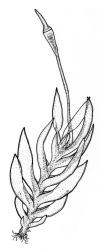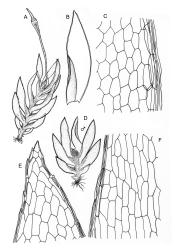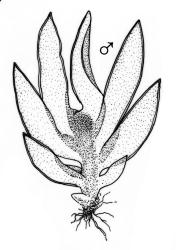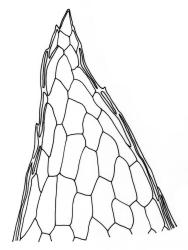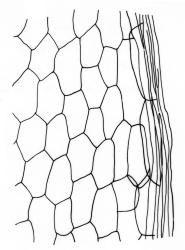Plants 5–8 mm, pale grey-green to dark green, delicate, loosely gregarious or as scattered individuals. Stems simple, pale, fleshy, with rhizoids at base only. Leaves in 4–8 pairs, not overlapping at mid stem, erect-spreading, decurved when moist, loosely crispate when dry, lanceolate, 1.5–2.5 × 0.3–0.7 mm; apex acute; laminae unistratose; vaginant laminae ½–⅔ leaf length, almost closed to closed; dorsal lamina reaching leaf insertion and shortly decurrent on stem, tapered to its base; margins entire, or with a few teeth near leaf apex; marginal cells on all laminae distinct in 1–3 rows, very narrow, prosenchymatous, thick-walled, forming well-defined and pluristratose borders; cells of apical and dorsal laminae irregularly hexagonal to pentagonal, smooth, non-bulging, lax, thin-walled, very large, (30–)40–80(–90) × 20–35(–45) µm. Costa apparently absent.
Dioicous. Perichaetia terminal; perichaetial leaves not differentiated from vegetative. Perigonia terminal, male plants generally smaller than female, with 4–7 pairs of leaves. Setae colourless, fleshy, 3–4 mm; capsules erect, symmetric, 0.6–1.0 mm; exothecial cells in c. 64 columns; operculum erect-rostrate from a conic base, equal in length to theca. Peristome scariosus-type; teeth with fimbriate adaxial trabeculae below the bifurcation, 40–50 µm wide at base. Calyptra smooth, mitrate. Spores 12–17 µm.
Wilson 1854, pl. 84, fig. 2; Stone 1986, fig. 3, d–f, q; Beever et al. 2002, p. 28, figs 1–4; Stone & Catcheside 2012.
Fissidens dealbatus, along with F. hylogenes, has traditionally been placed in Fissidens subgen. Aneuron Kindb., characterised by costae being absent and laminal cells usually very large and thin-walled (Suzuki & Iwatsuki 2007). However, Pursell & Bruggeman-Nannenga (2004) subsumed Aneuron within subgen. Aloma Kindb. Aloma was not subdivided by them, although there is great variation in border development, laminal cell ornamentation, and costa-type, in this subgenus. Pursell & Bruggeman-Nannenga (2004) state "gametophytically the subgenus [Aloma] is heterogeneous and at first glance seems to be incongruous. However, when considered with a world-wide perspective no sharp breaks among the sections recognised by Brotherus are apparent. In a given character there is intergradation from one end of the spectrum to the other." They characterised subgen. Aloma by a scariosus-type peristome, a bryoides-type costa (when present), fewer than 40 columns of exothecial cells, and mostly tropical and subtropical distributions. Fissidens dealbatus is somewhat anomalous in this group, having c. 64 columns of exothecial cells, and a temperate distribution.
Stone (1986) considered F. dealbatus to be distinct from the two other Australian species of Fissidens usually placed in subgen. Aneuron Kindb. (namely F. hyalinus Hook.f. & Wilson and F. splachnoides Broth.).
The delicate texture of the plants, with very large, thin-walled, leaf laminal cells, and more or less entire, bordered, leaf margins, as well as the apparent absence of a costa, make F. dealbatus readily recognisable in a N.Z. context. It is occasionally confused with F. hylogenes (which also lacks a costa) but that species has unbordered and serrate leaf margins and its plants are much smaller.
K; NI: N Auckland, S Auckland, Hawke’s Bay, Wellington; SI: Nelson (including D’U), Marlborough, Canterbury, Westland, Otago, Southland; St; Ch.
Australasian. Tasmania*, mainland Australia*. Recorded from New Caledonia by Iwatsuki & Suzuki (1989).
Fissidens dealbatus is a common species on damp, shaded, mineral soil, especially on stream banks and the sides of intermittent water courses, usually in indigenous forest. Frequent associates include F. curvatus, F. linearis, F. tenellus, and Achrophyllum dentatum.
Records are from near sea level (Rakiura/Stewart I.) to at least 800 m (Tararua Range, Wellington L.D.).



